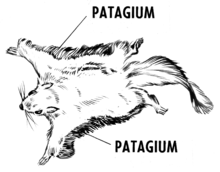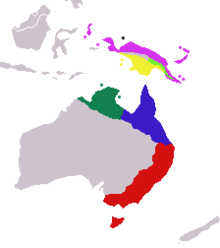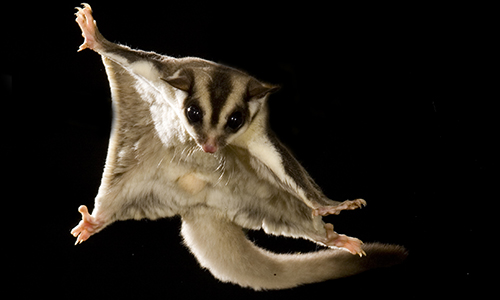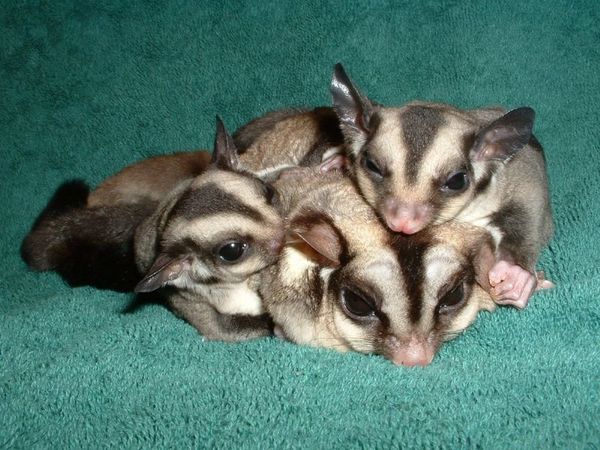SUGAR GLIDER
What is sugar glider?
 |
| source: www.wikipedia.org |
Sugar gliders are characterised by their gliding membrane,
known as the patagium, which extends from their forelegs
to hindlegs. They are covered in soft, pale grey to brown fur, which is lighter
in colour on their underside.
 |
| source: www.wikipedia.org |
Where are they from?
The sugar glider is endemic to
mainland Australia, New Guinea and certain Indonesian islands;
and it was introduced to Tasmania,
probably in the 1830s
Sugar gliders are found throughout the northern and eastern
parts of mainland Australia, Tasmania, New Guinea and several associated isles, the Bismarck Archipelago, Louisiade Archipelago, and certain isles
of Indonesia, Halmahera Islands of the North Moluccas.
What are they like?
 |
| source: www.wikipedia.org |
The sugar glider has a squirrel-like body with a long,
partially (weakly) prehensile tail. The length from the nose to the
tip of the tail is about 24 to 30 cm (12–13 inches), and males and
females weigh 140 grams and 115 grams respectively. Heart rate range is 200-300 beats per minutes, and
respiration rate is 16-40 breaths per minute. Male sugar gliders are typically
larger than the female ones. The fur coat on the sugar glider is thick, soft,
and is usually blue-grey; although some have been known to be yellow, tan or
(rarely) albino. A black stripe is
seen from its nose to midway on its back. Its belly, throat, and chest are
cream in colour. It is nocturnal, and its large eyes help it
to see at night, and its ears swivel to help locate prey in
the dark. The eyes of the sugar glider are set far apart, allowing them to
estimate the distance between launch and landing location during gliding.
How do they behave?
Like all arboreal, nocturnal marsupials, sugar gliders are
active at night, and shelter in tree hollows lined with leafy twigs during the
day.
What do they eat?
 |
| A sugar glider enjoying its food source: www.cuteness.com |
Sugar gliders are omnivores with a wide variety of foods in
their diet. Sugar gliders may obtain up to half of their water intake through
drinking rainwater, while getting the remaining intake from the foods they
consume. They prey mostly on lizards and small birds. They eat many other foods
when available, such as nectar, acacia seeds, bird eggs, pollen, fungi and
native fruits.
How do they
re-product?
The age of sexual maturity in sugar gliders varies slightly
between the males and females. Males reach maturity at 4 to 12 months of age,
while females require from 8 to 12 months. In the wild, sugar gliders breed
once or twice a year depending on the climate and habitat conditions, while
they can breed multiple times a year in captivity as a result of consistent
living conditions and proper diet.
 |
| A gliding sugar glider source: www.pinterest.com |
More facts about sugar gliders:
1. They are called sugar gliders because they like to eat things that are sweet, such as fruits and vegetables, and they have a gliding membrane (patagium) which allows them to glide from tree to tree.
2. Just like baby kangaroos, baby sugar gliders are also called "Joey" and the newborn babies are just in the size of a grain of rice.
3. Again, just like baby kangaroos, sugar gliders are marsupials, meaning the females have a pouch to keep their babies in.
4. Kangaroos and sugar gliders are in the same family, hence why they have so many things in common.
5. Sugar gliders have a life-span for about 12-15 years, similar to dogs and cats. However, the longest living sugar glider was recorded to live up to the age of 17,8 years.
6. Sugar gliders are roughly as intelligent as dogs since if they are properly trained, they can learn their names or even do tricks.
 |
| source: www.ozanimals.com |
7. It may sound too bad to be true, but some sources say that sugar gliders don't make good pets as they have a long life-span, can't be potty trained, sometimes purr and make noises at night. However, it depends on your commitment to keep them as your pets.
8. The good news is, although they can't be potty trained, they tend to be extremely clean so they won't poop or pee in something they sleep in.
9. There are sugar gliders that take a few days in order to bond with humans, there are even sugar gliders that take months to do so.
A video of sugar glider: https://youtu.be/sZ-PzBRSPsw
Sugar glider giving birth: https://youtu.be/OTFZzreIMTk
Sources: adapted from
- www.wikipedia.org
- www.sugargliderinfo.com
- www.babble.com
Komentar
Posting Komentar